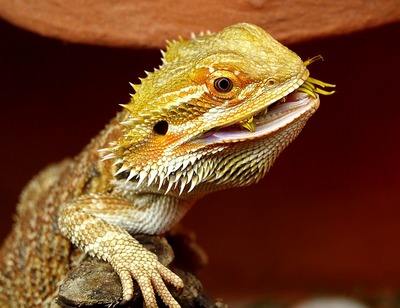In this post, you will find a bearded dragon complete diet and feeding guide, and all you need to know about bearded dragon diet.
We will discuss what you should and shouldn’t feed your bearded dragon, toxic plants and other foods for bearded dragons, best greens and vegetables, fruits and best and toxic flowers/plants to offer. Feeding guide will help you learn all about your bearded dragon’s ideal diet.
What do bearded dragons eat?
Bearded dragons are omnivores, which means that they eat both insects and greens. In captivity, bearded dragons eat mostly insects, flowers, vegetables, greens and fruits.
What do bearded dragons eat in the wild?
In the wild, bearded dragons eat different foods that they find. These can be small animals and various fruits, greens, vegetables and flowers.
How often does a bearded dragon need to eat? Bearded dragon feeding chart by age
| Bearded dragon age | How many times to eat per day or week | Insects | Salad |
| Baby bearded dragons (0-4 months) | 2-4 times per day, morning, afternoon, early evening | You will need to offer only feeder insects. | On top of that, have a bowl with salad in the tank to familiarize with greens/veggies/fruits. |
| Juvenile bearded dragons (4-7 months old) | Will need to eat 2-3 times a day – morning, late afternoon/early evening | Make sure your bearded dragon eats feeder bugs 2 times a day. | Also, have a bowl with some greens and start offering some too. |
| Subadult bearded dragons (7-12 months old) | 1 time per day. If your bearded dragon is growing slowly and is less than 7 inches at month 8-10, feed twice a day. | This will be 3-4 days a week with insects | 3-4 days/week with a salad. When reaching a 12 month old mark, move to 3 days/week with bugs, and 4 days/week with salad. |
| Adult (12-18 months and over, or 14 inches+) | 1 time per day (obesity can be a problem at this stage). Move slowly to mainly greens. | This will be 2 days/week with insects. | This will be 5 days/week with salads. |
| Old bearded dragon (6 years old and over) | 1 time per day | 2 days/week with non-fatty bugs only | 5 days/week with low calorie salads, and only little fruits. Can skip one day without feeding. |
| Brumating bearded dragons (over 12-18 months old, winter shutdown for 1-3 months) | No need to feed | No need to feed | Can offer some water, or very light salad if a bearded dragon is somewhat active. Healthy dragon should not lose any weight. |
What is Ca:P ratio in the food and why is it important?
When feeding your bearded dragon, you must always aim to reach at least 2:1 of Calcium to Phosphorus when feeding your dragon. Your bearded dragon must get more calcium than phosphorus.
This is why you will need to gut-load bugs to reach optimal Ca:P ratio. Also, you need to mix vegetables/greens the way to improve the ratio. Supplementing also helps to maintain healthy balance.
Which foods should I avoid giving to my bearded dragon too often?
Before we start discussing the list of foods that you can give to your bearded dragon, let’s discuss the ones that you shouldn’t offer often, and why.
Group of foods that you must avoid often are ones that are goitrogenic, high in oxalates and those that have a little nutritional value.
You should also avoid giving any soybean products (for example Edamame beans). They contain phytoestrogens, which lightly mimic hormones and can interfere with a bearded dragon’s reproductive health.
Remember, foods high in goitrogens, oxalates and low nutrition foods should make up only 10% of a bearded dragon’s diet. Same goes for fruits – only 10%. If fruits are also goitrogenic/oxalic, offer rarely.
The 1st group of foods to avoid giving too often are ones high in GOITROGENS.
Goitrogens are substances found is some foods that interfere with the organism’s ability to absorb iodine. If your bearded dragon consumes too many of these foods, it will develop a thyroid gland impairment.
Most vegetables that are goitrogenic are very nutritious, so you can feed them to your bearded dragon once in a while (once in a week or two). A little portion that you give to your bearded dragon occasionally should not cause any problems.
Here is a list of vegetables/greens high in goitrogens:
| Broccoli |  |
| Cabbage |  |
| Radish |  |
| Cauliflower |  |
| Kai Lan (Gai Lan/Chinese Broccoli) |  |
| Bok Choy (Pak Choi/Chinese Cabbage) |  |
| Brussel Sprouts |  |
| Rapini |  |
| Kohlrabi |  |
| Turnips |  |
| Rutabaga, or Swede |  |
Fruits high in goitrogens include:
- Apricots
- Cherries
- Peaches
- Pears
- Plums
- Raspberries
- Strawberries
Because these fruits/berries are goitrogenic, they should only make up less than 5% of your bearded dragon’s diet. Other fruits/berries that are more nutritious – 10% of the diet.
The 2nd group of foods to feed occasionally – OXALIC foods
You must not give your bearded dragon too much of high oxalate foods, as they disturb the absorption of any calcium from food.
When your bearded dragon eats foods high in oxalic acids, the calcium that is in the food doesn’t get absorbed – it binds with oxalates and leaves the gut without being absorbed.
Fruits and vegetables high in oxalates include:
- Beets and beet greens
- Carrots
- Celery
- Chard
- Kiwis
- Okra
- Parsley
- Radicchio
- Raspberries
- Spinach
- Star fruit
- Yucca (cassava)
Please note that you shouldn’t stop giving these foods completely to your bearded dragon – offer them once in 10 days or so.
When offering high oxalic foods, add some calcium supplement to the other food that your bearded dragon eats in a day.
Toxic foods for a bearded dragon – avoid them completely
Some foods, including insects and fruits & vegetables must be avoided completely. You should remember these foods and avoid them when it comes to feeding your bearded dragon.
Foods toxic to bearded dragons include:
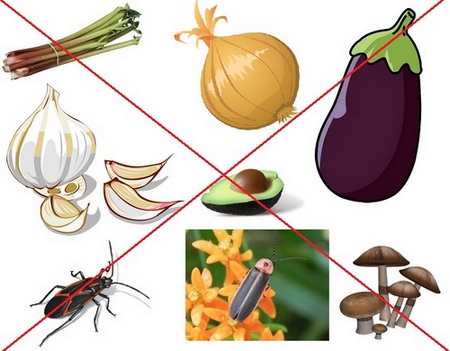
- Alcohol
- Apple/cherry/apricot/peach seeds
- Box elder bugs
- Bracken fern
- Buttercup
- Caterpillars and butterflies, especially Monarch
- Chives
- Eggplants, or aubergines – raw or cooked should not be given to bearded dragons;
- Fireflies, or lightning bugs (deadly)
- Garlic
- Leeks are thought to cause organ failure in larger quantities.
- Lubber grasshoppers
- Mushrooms
- Onions
- Rhododendron
- Rhubarb (deadly)
- Venomous spiders
- Wild caught insects
Avoid giving your bearded dragon bugs that sting or eat poisonous to your bearded dragon plants – such as bees, lady bug (ladybird), wasps, caterpillar, centipedes, monarch butterflies and others. They will poison or injure your bearded dragon.
While most of them will not kill your dragon if it eats them, try to avoid ingestion. Wasps, ants, spiders and scorpions can cause damage if they sting or bite.
Foods that are potentially toxic to bearded dragons:
- Unidentified berries
- Avocados (avoid feeding any – it is toxic to birds)
- Don’t feed your bearded dragon any houseplants
- Caffeinated drinks – tea, coffee or soft drinks
Be careful if you leave your bearded dragon outside in a playpen or other cage – fireflies can enter the cage. If your bearded dragon eats even one lighting bug, it will die very soon. There are a lot of fireflies in the U.S., especially in summer – be careful.

Best foods for bearded dragons
If you buy live insects online, they usually come in containers that contain food for them to grow. You need to act quickly if you need to feed your juvenile bearded dragon small worms or roaches, as they grow quickly.
You should only give your bearded dragon any large or fatty worms when it reaches 14-15 inches. This can be at around 10-12 months of age. Otherwise, they can cause choking and paralysis. These include mealworms, superworms and butterworms.
Best staple live feeder insects for bearded dragons
- Black soldier fly larvae (Phoenix worms/CalciWorms/Reptiworms) – great staple
- Silkworms (Bombyx Mori) – low fat and soft.
- Crickets (Acheta, Black or Banded) – cheap and easy to keep
- Tomato Hornworms (Goliath worms, Tobacco worms) – soft
- Turkestan roaches (Turkistan, Blatta Lateralis) – can’t climb/fly
- Discoid roach (Blaberus discoidalis/ False death roach)
- Dubia roaches (Blaptica dubia) – can’t climb or fly, large
- False Death Head Roaches (Blaberus Cranifer) – get big fast
- Grasshoppers – can be expensive
- Ivory head roaches ((Eublaberus sp. ‘Ivory’) – bulky nymphs, but expensive
- Locusts – can be expensive
- Lobster roaches (Nauphoeta cinerea) – can climb and fly, but good feeders
- Madagascar hissing cockroaches (Gromphadorhina portentosa)
- Orange head roaches (Eublaberus Posticus) – can’t fly/climb, but not legal everywhere
Main staple is the Phoenix worms and silkworms. Phoenix worms don’t need gut-loading/dusting because of good Ca:P ratio – 1.5:1. You can find more nutrition data in this food chart post.
All other insects require 24 hour gut-loading and dusting. Bearded dragon diet should consist of various foods and bugs. Diversity in a bearded dragon’s diet is a key.
Crickets for bearded dragons
Please note the size as juvenile and adult bearded dragons require different size crickets or it can cause choking. There are different types of crickets – brown Acheta, black ones and banded crickets. All of them are suitable. Crickets like this can be bought online.
Crickets are easily available and easy to care for. If you are buying a large number, you need to store them in a cricket pen like this which will make dispensing and feeding them easy.
If buying live crickets, you will have to feed or gut-load them before giving to your bearded dragon. Cons: they can smell and be loud. The Ca:P ratio is also low – 1:9, so you must gut-load properly.
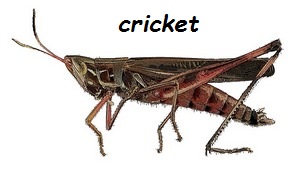
Cockroaches for bearded dragons
Suitable roaches are for example discoid roach (Haitian cockroach), young Madagascar hissing roaches, Dubia, Orange Head roaches and others – please note the size (juveniles and adults need different size roaches).
Dubia roaches are very good as they are high in protein and rather low in fat. They are also quiet and find it hard to climb, making escapes harder. You can buy various size Dubias like this.
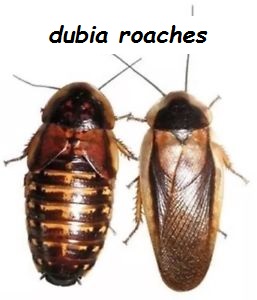
Tomato hornworms for bearded dragons
Bearded dragons love hornworms, because they have a soft exoskeleton and are easily digestible. They are also very large – only few of them can make a whole meal for your bearded dragon! Excellent choice for a frequent bearded dragon meal.
Hornworms usually come in a cup with the food for gut-loading. You can get hornworms like this in a cup with the ready food.
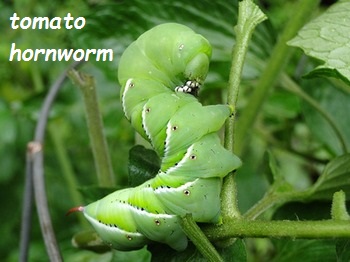
Occasional bearded dragon live food insects
- Mealworms like this. Only for adult bearded dragons of over 15 inches long.
- Large mealworms, or superworms like this. Mealworms are easy to keep, but they are not easily digested by bearded dragons, due to high chitin content in their skeletons. Superworms are often softer and larger in size, so you will need less of them to make a meal. Offer only to adults.
- Wax worms – they are high in fat (up to 25%) and you should give them to your bearded dragon only occasionally as a treat or to fatten up a bearded dragon. You can also give them to a breeding or egg-laying females, as fat is important for creating healthy eggs.
- Butterworms – occasionally. Good source of calcium and protein – making it a good choice for food.
More occasional feeder insects to feed bearded dragons
- Earthworms – occasional treat. Wash them before feeding and make sure they don’t contain any dyes. Low in fat, good source of calcium.
- Pinkie mice – also called fuzzy mice. These mice are juveniles and don’t have any fur. You can feed your bearded dragon a pink mouse. You can get frozen pinkies like this, store them in your freezer and take one out for occasional feeding. Use feeding forceps and shake the mouse a little to activate dragon’s interest to eat.
- Fruit flies – very small and you will need a lot to make a meal. Suitable for smaller dragons, otherwise won’t spark hunting instincts.
- Six-spotted roaches (Eublaberus Distanti) – high in fat (27%) and have spines on their legs.
- Buffalo worms (Alphitobius diaperinus) – high in fat (27%), so only offer as a treat. Avoid feeding beetles.
- Surinam cockroaches (Pycnoscelus surinamensis) – slightly hard to maintain and they burrow quickly. Most Surinam roaches are females, making copies of themselves to breed.
Bugs that are toxic to bearded dragons
- Houseflies – they are too small, escape easily and your bearded dragon will waste too much energy on one bug. If you can offer large number of flies that don’t fly, it can be suitable.
- As discussed above, box elder bugs, wasps, bees, lady bugs, and fireflies are all dangerous and toxic, so avoid them altogether.
Best staple vegetables, greens and fruits for bearded dragons
To feed your bearded dragon any vegetables, you must chop them to smaller pieces before offering. Size of chopped vegetables should depend on the age of your bearded dragon, but finely chopped pieces are always the best.
Before feeding any fruits to your bearded dragon, remove the seeds – they pose a risk of choking. Some seeds are also toxic to bearded dragons – such as apple, apricot, cherry and peach seeds!
Fruits should represent only 10% of bearded dragon’s diet. If offering goitrogenic/oxalic/low nutritious fruits – such as watermelons, cherries and more from the list above, then only 5%.
Acceptable (higher oxalic fruits) should only be given few times a month. Offer fruits to your bearded dragon 1-2 times a week.
| Best vegetables, greens and fruits for your bearded dragon – feed daily | Good vegetables, greens and fruits for your bearded dragon – feed few times a week | Acceptable (including goitrogens and high oxalate foods) vegetables, greens and fruits (should represent 10% of the diet) for your bearded dragon | Bad (poor in nutrients) or toxic vegetables, greens and fruits for your bearded dragon. |
| Scallop squash | Artichoke (heart) | Beans, Lima | Potatoes (sweet or Russet) – high in phosphorus and starchy. Boil. A rare treat |
| Squash – winter squashes especially | Asparagus | Bok Choy | Corn – give rarely because they are high in phosphorus. |
| Basil | Chayote | Brussel sprouts | Garlic – toxic |
| Rocket (Arugula) | Bell peppers (red, green, yello) – red in higher in vitamin C | Rapini | Orange – can cause digestive upsets and runny stools – give rarely, but check the reaction first with a small portion. |
| Collard greens | Cantaloupe melon | Rutabaga (Swede) | Grapes – debated to cause |
| Spaghetti squash | Apples (peeled and sliced) for a treat | Spinach | Onions (any from the onion family, including spring onions) |
| Dandelions – leaves and flowers | Cilantro (Coriander) | Cabbage | Swiss chard – very high in oxalates |
| Hubbard squash | Figs | Radish | Raspberries – high in oxalates |
| Acorn squash | Garbanzo beans/chickpeas | Parsley | Parsley – very oxalic |
| Peppermint | Green beans – high in protein but also in phytic acid that can bind calcium. Offer in moderation. | Cucumber – feed rarely, mainly for water | Chives – toxic |
| Rosemary – mix some fresh leaves to entice to eat a salad | Green peas – small quantities | Green cabbage | Eggplant, or aubergines – potentially toxic |
| Escarole | Kale | Celery | Star fruit – high in oxalates |
| Clover leaves and blossoms | Mango | Snow peas | Leeks – potentially causing anemia and organ failure in higher quantities, avoid. |
| Endive | Papaya | Honeydew melon | Zucchini (courgette) – high in phosphorus |
| Thyme – mix some fresh leaes to entice to eat a salad | Parsnips | Beetroot | Edamame (soybean) – contains isoflavones that can mimic female hormones |
| Butternut squash | Pinto beans | Carrots and carrot tops | Tomatoes – very acidic |
| Kabocha squash | Pumpkins | Wheatgrass | Pomegranate |
| Chicory greens | Radicchio | Broccoli | Mushrooms – any |
| Mustard leaves and blossoms | Snap peas – small quantities | Okra | Avocado – potentially toxic |
| Alfalfa – fresh plant and not dried pellets | Watercress | Celery – vegetable and leaves | Grapefruit – can cause digestive upsets and runny stools – give rarely, but check the reaction first with a small portion. |
| Turnip greens | Beet greens | Rhubarb – very toxic | |
| Cactus pads – prickly pear leaves/pads | Zucchini, or courgettes – feed rarely, mainly for water. | Bananas – very high in phosphorus. It binds with calcium and removes it from the body. In bigger quantities can also cause digestive upsets due to high sugar content. | |
| Mint – mix some fresh leaves to entice to eat a salad | Turnips | Kiwi – high in oxalates | |
| Yellow squash | Cauliflower | Pineapple – acidic, only in very small quantities if at all | |
| Apples | Any citrus fruits, including grapefruit, oranges, limes, lemons, kumquats – can cause serious digestive issues | ||
| Peaches, pears, plums, strawberries, cherries, guava, blueberry, blackberries, cranberries, figs, nectarines, blueberries, apricots, watermelon | Cassava (Yucca) – contains saponins and phytates that in larger amounts can damage digestive system. Avoid. | ||
| Leafy greens (romaine lettuce, iceberg, green leaf) – low nutrients, good for hydration. Big quantities can cause diarrhea. | |||
| Kohlrabi | |||
| Yams | |||
| Snap peas |
Best flowers for bearded dragons, and toxic flowers
When feeding your bearded dragon, don’t forget about flowers, too. Bearded dragons in the wild consume a lot of different flowers and greatly enjoy them.
The main rule to remember before feeding your bearded dragon any flowers is that they should not be sprayed with any pesticides or fertilizers or taken from places where they grow near city roads (pollution contamination).
Here is a list of flowers that you can offer your bearded dragon, and ones that you must avoid – they are toxic or cause serious reactions in beardies.
| Best and acceptable flowers to feed your bearded dragon | Bad and toxic plants or seeds that you MUST NOT feed your bearded dragon |
| Dandelions – high in calcium – can offer every other day | Daffodils – highly toxic |
| Hibiscus – whole plant – high in calcium – can offer every other day | African violet |
| Nasturtiums – high in calcium – can offer every other day | Tiger lily |
| Maple leaves | Apple seeds |
| Alfalfa | Cherry seeds |
| Mulberry leaves | Peach seeds |
| Roses petals | Potato plant, leaves and flowers – toxic |
| Borage | Eggplant plant, leaves and flowers – toxic |
| Petunia flowers | Tomato plant, leaves and flowers – toxic |
| Marigold (Calendula) | Apricot seeds |
| Clover – red and white | Azalea |
| Chamomile, or camomile flower | Begonia |
| Geranium flowers and leaves | Bloodroot |
| Tarragon | Buckthorn |
| Carnation petals | Bracken Fern |
| Impatiens flowers | Black Locust |
| Dahlia (flower) | Nightshades |
| Pansies (flower) | Amaryllis |
| Amsinckia | |
| Aconite | |
| Acokanthera | |
| Aloe | |
| Arrowhead Vine | |
| Anemone | |
| Boston Ivy | |
| Bluebonnet | |
| Bleeding heart |
Commercial bearded dragon foods
You can also find and buy commercially prepared foods for bearded dragons. These foods are very useful when someone is watching your bearded dragon, and you don’t want to make them feed live insects or make salads.
You can also use them when you don’t have any salads or insects, or when you didn’t have the time to prepare bearded dragon’s food.
Commercial pelleted or can foods must not replace healthy vegetables, greens and insects. Feed them along with other fresh foods and insects for a diversity or when required.
Don’t offer commercial foods until your bearded dragon is a juvenile.
Pelleted food pros is that they have been supplemented with vitamins and minerals for a beardie of specific age, so you don’t need to dust the food. Cons of commercial foods is that your bearded dragon might not accept it unless you vibrate the bowl or trigger hunting behavior.
Another disadvantage of pellet foods is their low water content (usually 5-10% opposed to 70-90% in vegetables and greens). When feeding your bearded dragon pelleted foods, make sure it drinks more water.
Some options for pelleted bearded dragon foods are:
- Soft and moist bites by Nature Zone
- Adult bearded dragon pelleted food
- An omnivore treats pack – mix of vegetables, fruits and insects
- Exo Terra soft adult bearded dragon food
- Repashy grub pie/insects + fruit CGD and more
There are much more options of pelleted foods. When buying, try to avoid products that have a little water content (5% or less).
For example, a commercial strawberry salad dressing for bearded dragons is totally unnecessary. It has a high sugar content and can make your bearded dragon used to eating the salad with this artificial dressing.
Supplementing bearded dragon food
You will also need to supplement your bearded dragon’s food with Calcium and multivitamins separately. You will need to get a separate calcium, then calcium + vitamin D3 (not necessary) and separate multivitamin for separate days.
Depending on the age, you will need to supplements differently. Please read this full post on supplementation here to find best vitamins and a chart.
Thank you for reading this diet post!
To read about supplementing dragon’s food, read here.
You can also find a list of around 350 foods that you can and cannot feed your bearded dragon here.

